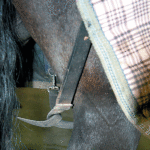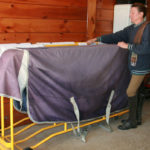A cold horse shivers. it’s that simple. A horse with too much blanket sweats. A healthy horse with a dense winter coat and good flesh may not require blanketing. But many also emerge from winter in poor condition because they needed a blanket for added warmth. Our temperature chart, below, will help you make decisions, but remember that each horse has individual tolerances.
Windy conditions don’t interfere with the insulating value of
the horse’s coat, but it does whisk away heat from the body faster, so pay attention to wind chill. Moisture?s the greatest problem. Any horse that gets wet in cold weather will become chilled quickly, making a waterproof-breathable rug or shelter a necessity. Older horses and thin-skinned horses are especially sensitive to these conditions.
Genetics may also play a role. A horse that doesn’t grow a thick, dense coat, such as many Thoroughbreds, will need a blanket sooner than a Shetland Pony.
Consider, too, that if your horse is going to be in active use over the winter, you’ll likely want to clip him, which means he’ll need a blanket. Unclipped horses can overheat quickly, and sweat will accumulate in the long coat. The salts from sweat are irritating to the skin and increases its pH. This puts the horse at higher risk of skin problems, rubs and infections.
The most efficient way to blanket is layering, as it allows maximum flexibility. A cotton sheet or smooth surfaced fitted cooler is the inner layer. it’s easiest to have two additional medium-weight blankets, adjusting with one or two, depending upon the temperature changes.
All outer-layer blankets must be waterproof and breathable. If the blanket is breathable, it allows the moisture from his skin to rise out of the blanket. If the material isn?t breathable, that moisture can condense and the horse will become wet and chilled. (See September 2009 stable blankets and September 2008 for turnout blankets at www.horse-journal.com.)







